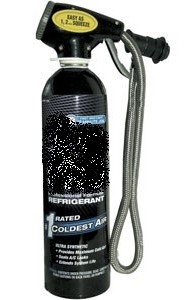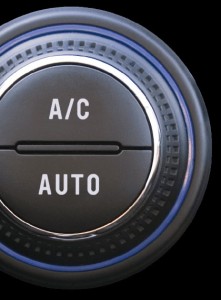The Dangers of DIY Manual A/C Recharge Kits
Posted August 1, 2014
Summer is here, and it brought the heat to Littleton! If your car’s air conditioning isn’t holding up to the temperatures, you may need to have your a/c inspected.
We’ve heard several people talking about DIY manual recharge kits that let you add refrigerant into your system. Many of these kits seem like an easy, “too good to be true” alternative to a full A/C service – that’s because it is too good to be true!
 Manual Recharge Basics
Manual Recharge Basics
Manual recharge systems do not evacuate the fluid in your system – instead they add refrigerant on top of your current levels. It’s like adding new oil on top of old oil – topping off fluids does not solve any problems, only temporarily covers up the symptoms. In fact, topping off can even lead to bigger problems and costly repairs!
Leaking refrigerant
Refrigerant does not evaporate, it leaks. If your air conditioning is low on refrigerant, it is leaking refrigerant into the atmosphere. The refrigerant in older vehicles is CFC-12 (also known as Freon), which depletes the ozone layer. This type of refrigerant is no longer manufactured in the United States due to its negative environmental effects. While the environmental impacts of leaking refrigerant are significant, DIY kits pose many more risks to your vehicle.
Contaminants in your system
Not only can refrigerant continue to leak into the atmosphere, but contaminants can leak into your system. Dirt, dust, and grime can build up inside your A/C, plugging up the hoses and pumps necessary to keep your car cool. Even water can wreak havoc in your system!
Manual recharge kits often leave water behind in the lines. When water and refrigerant mix, they will hydrolyze – forming hydrochloric or hydroflouric acids that can deteriorate parts, corrode metal, and fill the system with sludge. This can cause problems much more costly than the few dollars you save purchasing the DIY recharge kit.
 Mixing Refrigerants
Mixing Refrigerants
Because there are many types of refrigerant, you may not know if the refrigerant you are adding is the same as the refrigerant currently in your system. Mixing refrigerants can cause dangerous chemical interactions. In addition, mixing refrigerants can cause damage to the compressor or other parts of the air conditioner. If you cannot identify the type of refrigerant in your system, you should evacuate the system and replace with new refrigerant rather than risking “topping off” with the wrong type.
Bigger Problems
Many recharge kits also feature a stop-leak sealer, claiming to fix and prevent leaks. One of two things typically happen with these sealers – either it won’t work at all and you will continue to leak Refrigerant into the atmosphere, or it will stop the leak, as well as the hoses, the compressor, and the pumps in your A/C! Kits that offer a “stop-leak sealer” may temporarily plug leaks, but can interfere with system components and lead to larger, costly repairs.
If there is a problem in the A/C system, DIY kits will only cover up the symptoms temporarily. Water and contaminants can get into the system, refrigerant can leak out into the environment, and leaks are not repaired. All of these factors can lead to even more problems, and more expensive repairs, for your vehicle.
Leave it to the experts
A/C systems in vehicles require precision – manufacturers determine a specific amount of refrigerant that is correct for your car. When you bring your car into our shop for a recharge, you can trust that your air conditioning will be working properly without the harmful risks associated with the manual DIY kits. To schedule an A/C inspection, recharge, or repair, call us at 303-347-1010 and keep cool this summer!
Categories: Car Care Tips
Tags: , A/C Repair Littleton, auto ac recharge, auto air conditioning, diy ac recharge

